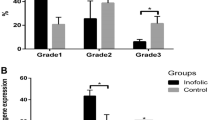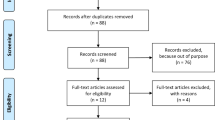Purpose
This study was designed to investigate whether the level of myo-inositol (MI) in human serum is critical for embryotrophic activity.
Methods
The embryotrophic properties of human serum were evaluated by the development of postimplantation mouse embryos [in vitro assay of Tam et al.(Fertil Steril 48:834–839, 1987)].An enzymatic spectrophotometric method using myo-inositol dehydrogenase was used for determination of serum MI. The level of MI detected in serum was compared with the embryotrophic properties and the pregnancy outcome. The effect of MI on the embryotrophic activity of human serum was studied by supplementing the suboptimal serum samples that were unsupportive of embryo growth with extra MI.
Results
Serum obtained from patients having successful IVF pregnancies generally supported better development of postimplantation mouse embryos and contained higher levels of inositol, particularly if the serum sample was collected during the IVF treatment cycle. Serum samples obtained from patients with aborted pregnancies, though supporting mouse embryo development, contained significantly lower concentrations of inositol. An improvement of the embryotrophic properties with exogenous inositol supplement was achieved in some but not all of the suboptimal serum samples studied.
Conclusions
It is possible that other factors in addition to inositol are crucial in promoting better embryonic development.
Similar content being viewed by others
References
Leung PCS, Gronow MJ, Kellow GN, Lopata A, Speirs AL, McBain JC, duPlessis YP, Johnston I: Serum supplement in human in vitro fertilization and embryo development. Fertil Steril 1984;41:36–39
Paul J: Cell and Tissue Culture Technique, 5th ed. Edinburgh, Livingstone, 1975
Wasley GD, May JW: Animal Cell Culture Methods. Oxford, Blackwell Scientific, 1970
Ackerman SB, Swanson RJ, Stokes GK, Veeck LL: Culture of mouse preimplantation embryos as a quality assay for human in vitro fertilization. Gamete Res 1984;9:145–152
Condon-Mahony, Wortham JWE, Bundren JC, Witmyer J, Shirley B: Evaluation of human fetal cord sera, Ham's F-10 medium, and in vitro culture materials with a mouse in vivo fertilization system. Fertil Steril 1985;44:521–525
Shirley B, Wortham JWE Jr, Witmyer J, Condon-Mahony M, Fort G: Effects of human serum and plasma on development of mouse embryos in culture media. Fertil Steril 1985;43:129–134
Shirley B, Wortham JWE Jr, Peoples D, White S, Condon-Mahony: Inhibition of embryo development by some maternal sera. J Vitro Fert Embryo Transfer 1987;4:93–97
Shaw JM, Harrison KL, Wilson LM, Breen TM, Shaw G, Cummins JM, Hennessey JF: Results using medium supplemented with either fresh or frozen stored serum in human in vitro fertilization. J Vitro Fert Embryo Transfer 1987;4:5–9
Saito H, Berger T, Mishell DR Jr, Marrs RP: The effect of serum fractions on embryo growth. Fertil Steril 1984;41:761–765
Kruger TF, Stander FSH, Smith K, Van der Merwe JP, Lombard CJ: The effect of serum supplementation on the cleavage of human embryos. J Vitro Fert Embryo Transfer 1987;4:10–12
Makler A, Fisher M, Murillo O, Laufer N, DeCherrey A, Naftolin F: Factors affecting sperm motility. IX. Survival of spermatozoa in various biological media and under different gaseous composition. Fertil Steril 1984;41:428–432
Tam PPL, Chan WY, Mao KR, Chiu T: A correlative study on the embryotrophic property of patient's serum and the outcome of in vitro fertilization of human oocytes. Fertil Steril 1987;48:834–839
Menezo Y: Culture media and embryo metabolism: The influence of serum addition.In In Vitro Fertilization and Embryo Transfer, W Feichtinger, P Kemeter (eds). Palermo, Cofese, 1984, p 159
Kane MT, Bavister BD: Vitamin requirements for development of eight-cell hamster embryos to hatching blastocysts in vitro. Biol Reprod 1988;39:1137–1143
Eagle H, Oyama VI, Levy M, Freeman AE: Myo-inositol as an essential growth factors for normal and malignant human cells in tissue culture. J Biol Chem 1957;226:191–205
Clements RS Jr: Diabetic neuropathy—new concepts of its etiology. Diabetes 1979;28:604–611
Sussman I, Matschinsky FM: Diabetes affects sorbitol and myo-inositol levels of neuroectodermal tissue during embryogenesis in rat. Diabetes 1988;37:974–981
Weigensberg, Garcia-Palmer FJ, Freinkel N: Uptake of myo-inositol by early-somite rat conceptus. Diabetes 1990;39:575–582
Cockroft DL: Changes with gestational age in the nutritional requirements of postimplantation rat embryos in culture. Teratology 1988;38:281–290
Baker L, Piddington R, Goldman AS, Dahlem S, Egler J: Myo-inositol (MI) and arachidonic acid (AA) are linked in the mechanism of diabetic embryopathy. Diabetes 1986;35(Suppl 1):12A (abstr)
Eisenberg F Jr: D-Myoinositol 1-phosphate as product of cyclization of glucose 6-phosphate and substrate for a specific phosphatase in rat testis. J Biol Chem 1967;242:1375–1382
Cooke AM, Nahorski SR, Potter BVL: Myo-inositol 1,4,5-trisphosphorothioate is a potent competitive inhibitor of human erythrocyte 5-phosphatase. Fed Eur Biochem Soc 1989;242:373–377
Saltiel AR: The role of glycosyl-phosphoinositides in hormone action. J Bioenerg Biomembr (US) 1991;23:29–41
Berry N, Nishizuka Y: Protein kinase C and T cell activation. Eur J Biochem 1990;189:205–214
Hod M, Star S, Passonneau JV, Freinkel N: Rat embryo culture—prevention of hyperglycemia induced malformations with aldose reductase inhibitors and myoinositol.In Proc Annu Meet Isr Endocr Soc, Jerusalem, Dec 1986, pp 4–15
Porter RN, Smith W, Craft IL, Abdulwahid NA, Jacobs HS: Induction of ovulation for in-vitro fertilization using buserelin and gonadotropins. Lancet 1984;1:1284–1285
Lejeune B, Delvigne A, Barlow P, Vanrysselberg M, Puissant F, Leroy F: Use of buserelin acetate in an in vitro fertilization program: A comparison with classical clomiphene citrate-human menopausal gonadotropin treatment. Fertil Steril 1990;54:475–481
Loong EPL, Tam PPL, Chiu TTY, Chan MYM, Panesar NS, Lau J: Controlled ovarian hyperstimulation for in vitro fertilization using buserelin and gonadotropin in patients with previous failed cycles. Asia-Ocean J Obstet Gynaecol 1990;16:297–300
Chiu TT, Tam PP: Contamination of culture medium with endotoxin affects embryonic development in vitro. Aust J Med Lab Sci 1991;12:130–133
Brown NA, Fabro S: Quantitation of rat embryonic development in vitro: A morphological scoring system. Teratology 1981;24:65–78
Lowry OH, Rosebrough NJ, Fan AL, Randall RJ: Protein measurement with the Folin reagent. J Biol Chem 1951;193:265–275
Dolhofer R, Wieland OH: Enzymatic assay of myo-inositol in serum. J Clin Chem Clin Biochem 1987;25:733–736
Gardner HG, Kaye PL: Effects of insulin on preimplantation mouse embryo development in vitro.In Proceedings of the Australian Society of Reproductive Biology 1984, Abstr 107
Caro CM, Trounson A: The effect of protein on preimplantation mouse embryo development in vitro. J Vitro Fert Embryo Transfer 1984;1:183–187
Clements RS, Reynertson R: Myoinositol metabolism in diabetes mellitus. Effect of insulin treatment. Diabetes 1977;26:215–221
Esbenshade KL, Ziecik AJ, Britt JH: Regulation and action of gonadotropins in pig. J Reprod Fertil Suppl 1990;40:19–32
Conway GS, Jacobs HS, Holly JM, Wass JA: Effects of luteinizing hormone, insulin, insulin-like growth factor-1 and insulin-like growth factor small binding protein 1 in the polycystic ovary syndrome. Clin Endocrinol 1990;33:593–603
Prelevic GM, Wurzburger MI, Peric LA: The effect of residual beta cell activity on menstruation and the reproductive hormone profile of insulin-dependent diabetics. Arch Gynecol Obstet 1989;244:207–213
Hod M, Star S, Passonneau J, Unterman TG, Freinkel N: Glucose-induced dymorphogenesis in the culture rat conceptus: Prevention by supplementation with myo-inositol. Isr J Med Sci 1990;26:541–544
Gwatkin RBL, Williams DT: Immunization of female rabbits with heat-solubilized bovine zonae: Production of anti-zona antibody and inhibition of fertility. Gamete Res 1978;1:19–26
Yates CA: Male-factor infertility and in vitro fertilization. J Vitro Fert Embryo Transfer 1987;4:141–147
Harvey MB, Kaye PL: Insulin increases the cell number of the inner cell mass and stimulates morphological development of mouse blastocysts in vitro. Development 1990;110:963–967
Author information
Authors and Affiliations
Rights and permissions
About this article
Cite this article
Chiu, T.T.Y., Tam, P.P.L. A correlation of the outcome of clinical in vitro fertilization with the inositol content and embryotrophic properties of human serum. J Assist Reprod Genet 9, 524–530 (1992). https://doi.org/10.1007/BF01204248
Received:
Accepted:
Issue Date:
DOI: https://doi.org/10.1007/BF01204248




